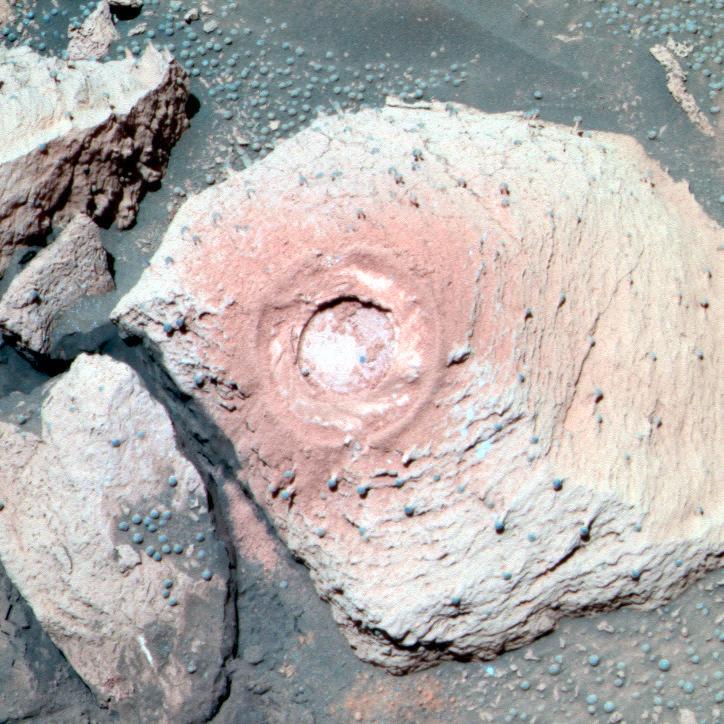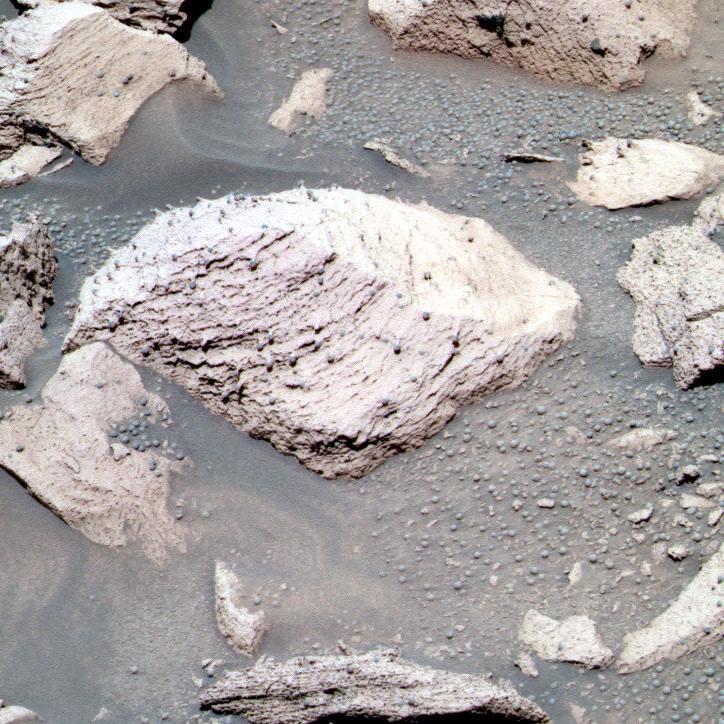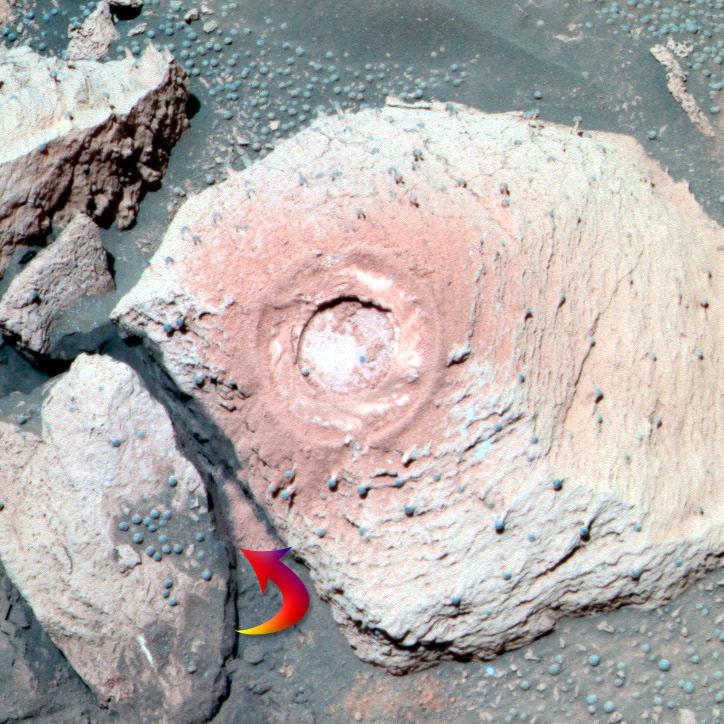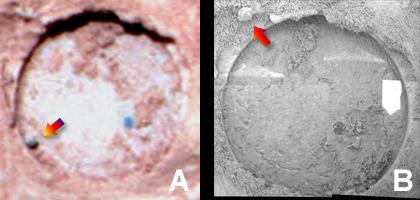|
Some time ago Space Freedom published an article that has soon become, among
many articles about Mars, one of the most read and appreciated and that raised
not few discussions inside lots of forum or subject lists dedicated to the red
planet, to the N.A.S.A and E.S.A missions and to the possibility of finding
life, past or present, on this planet, so near and so fascinating for us.
The article entitled Blueberry Fields File’s - Salt or life?
Speculation on the mysterious Martian "blue sphere-like" …..Or: "Dialogue
between Space Freedom and one reader"
The article is of sure signed by the undersigned but, for its peculiarity, it
would not have been so appreciated without the collaboration of my interlocutor,
Alessio Feltri, one Space Freedom reader who, by his perspicacity, by the
skilfulness of his cultural and professional formation and, not least, by a good
deal of nonconformity, raised a discussion about the anomalies caught, in these
last three months, in the different photos taken by the Nasa and by the robot
Opportunity on Meridiani Planum.
I wondered, very often, if the readers of a web site have an idea of what
happens behind the direction of a web site or if they ask what is hidden behind
the issue of an article; well, this time, in this specific case, one should have
been asked "what may happen exactly after the publication of an article?" and
once only the answer will be published and it will be the same webmaster to make
it known: sometimes, after an article originated by a direct contact with an
expert (this is happening, for instance, with dr. Thorsten Becker for the fairy
circles of Namibia), with a research group as a capable reader, further contacts
take place, a dialogue beyond a published article; this is, perhaps, the nicest
experience, undoubtedly more satisfying than the pure success of a personal
article, this is what has happened with Alessio Feltri.
The dialogue, meantime, has never ended and, as agreed with him, after many
days since the beginning of this "wire" between us, made of questions and
answers, of hypothesis and theories followed day by day or, I should say, from a
Martian Sol to the other, we have decided together to propose to you a little
example of such discussions, aware that is good to share with all the Space
freedom’s friends, of Mars and its mysteries.
◊◊◊
Campaniolo :
Hi Alessio, news images from Meridiani Planum… The blueberries, don’t you
think that the blueberries have to tell more than what have been already told?
Opportunity is out of the crater in which it landed and that have been
considered by the Nasa technicians a possible old basin of salt water, a pool
where these concretions formed for the interaction between the water and the
nature of the rocks of blueberries.
below; well, today, rather far from that crater, the spherule
are everywhere, a true sea
Feltri:
Yes, they are everywhere. Look carefully this picture.

This rock, found in the "Fram Crater" and called by the NASA "Pilbara", was
analysed in Sol87 by the RAT (Rock Abrasion Tool) of Opportunity.
Campaniolo:
Yes! I had seen it in black and white, too. Very strange as concretions, they
have much different characteristics from those we can see on the Earth, even
from the only ones of spherical shape and that sometime are found inside the
carsic caves, the pisolitic, aggregate composed of small,
spherical particles, don’t you think? I think it’s intriguing to point out how
some are tied to the rock by a filament, a peduncle, while others not. What do
you think?
Feltri:
The fact that the little balls located on the "stems" seen in the photos are
strange as concrezioni is more than logical, for the simple reason that ...are
not concretions.
To understand it we can look to the following picture two previous photos (in
different conditions of light) of a little ball, that by chance was positioned
in a place where a break in the rock occurred.

As you may see the material of the "peduncle" connected to the little ball is of
different material from that of the same ball, as confirmed, besides, from the
colour pictures in which the filters of the Pancam divide the blue-grey balls
from the white peduncles.
Since the actual peduncles in the inorganic concretions are always of the same
material of the balls, we cannot avoid to assume that the blueberries are not
concretions.
To explain why in this case the peduncles are visible and in other cases are
not we must watch how "Pilbara" was before the RAT intervention.

As you may see this rock is higher than the surrounding ones and besides it has
sharp angles and sub-triangular shape, that is to say it has been long time
subjected to the erosion of the wind, that may have removed the substratum
around the peduncles. Indeed in the lower part of the rock the peduncles are not
almost visible.
I noticed how the different position of the rock on the left of Pilbara, in the
two pictures, is due to the fact that, during the operations of the RAT, the
wheels of the rover laid down on the rock almost turning it over, as pointed out
by the arrow in the following photo.

Campaniolo:
Interesting considerations that make me arise other questions and some doubts,
I will ask you soon but I would like ask you what do you think about another
aspect that I noticed on this rock of "Fram Crater".
If I move to look at the hole of the RAT I wonder to find one of these
blueberries inside completely whole; I refer to the one lower on the left: did
it fall afterwards? Was there? And if there was, have they drilled around? It
seems not possible to me. I feel that it is at a lower level than the rock
surface. Did you wonder?
Concerning the untouched blueberry in the circle of the RAT, the answer is in
the following picture.

In the photo B, taken by Microscopic Imager, the arrow on the left shows the
ball that in the photo A, taken afterwards, seems to be slipped in the new
position, probably it detached from the substratum during the operations of
turning back of the robotic arm.
About the ball that in the photo appears sectioned, in the right centre of the
part drilled by the RAT, it cannot be avoided to point out how there are
interesting analogies with some forms of earth’s deposit algas , epilitical and
mild endolitical (up to a deep of 8-9 mm.), in which nucleus and rizoids can
completely hard and remain alive only externally.
Margherita Campaniolo
Alessio Feltri
|
|

